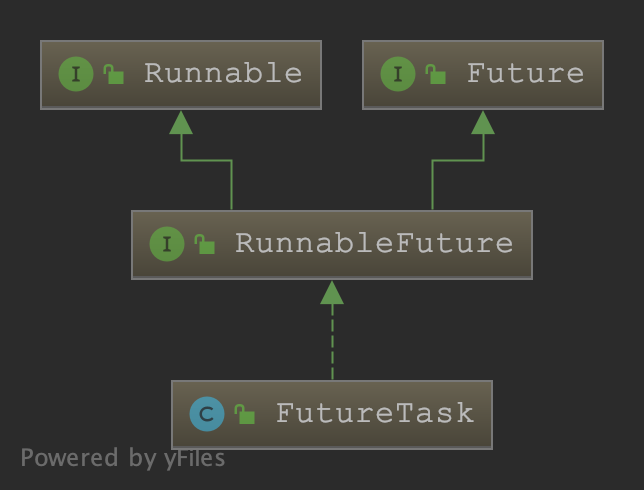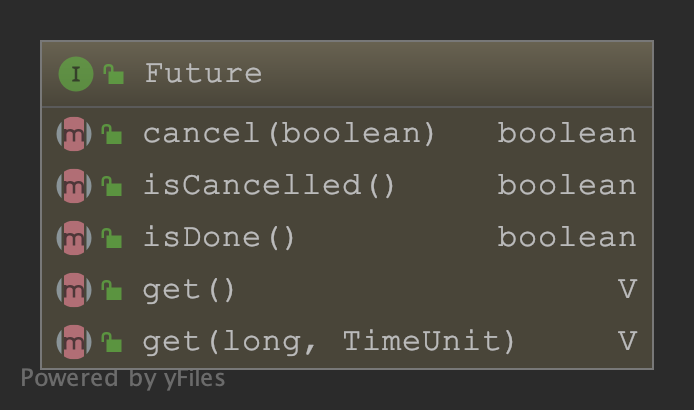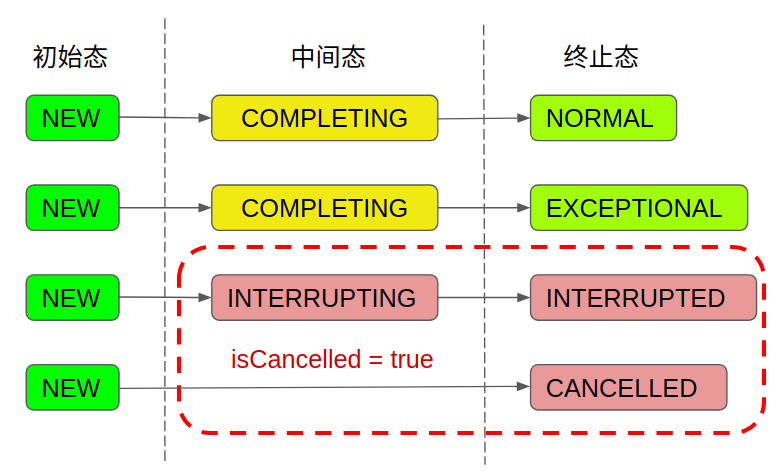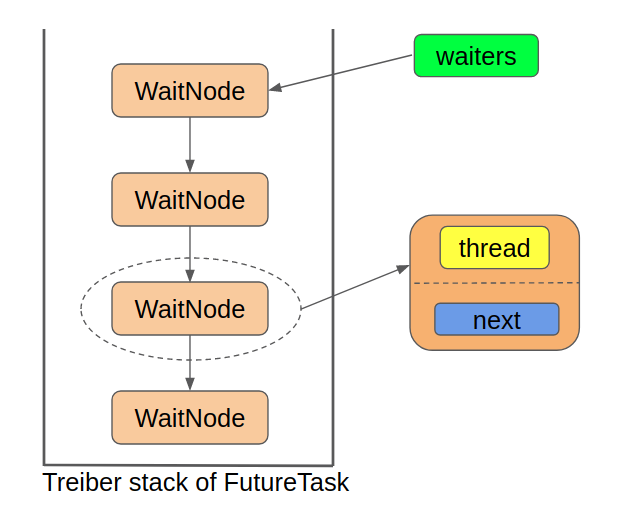JDK源码分析-FutureTask
概述
FutureTask 是一个可取消的、异步执行任务的类, 它的继承结构如下:

它实现了 RunnableFuture 接口,而该接口又继承了 Runnable 接口和 Future 接口,因此 FutureTask 也具有这两个接口所定义的特征。 Future Task 的主要功能:
1. 异步执行任务,并且任务只执行一次;
2. 监控任务是否完成、 取消任务 ;
3. 获取任务执行结果。
下面分析其代码实现。
代码分析
分析 FutureTask 的代码之前,先看下它实现的接口。 RunnableFuture 接口定义如下:
public interface RunnableFuture<V> extends Runnable, Future<V> {
/**
* Sets this Future to the result of its computation
* unless it has been cancelled.
*/
void run();
}
R unnableFuture 接口继承了 Runnable 接口和 Future 接口,而 Runnable 接口只有一个 run 方法 ,这里不再赘述。下面分析 Future 接口。
Future 接口
Future 接口方法定义如下:

主要方法分析:
/*
* 尝试取消执行任务。若任务已完成、已取消,或者由于其他某些原因无法取消,则尝试失败。
* 若成功,且调用该方法时任务未启动,则此任务不会再运行;
* 若任务已启动,则根据参数 mayInterruptIfRunning 决定是否中断该任务。
*/
boolean cancel(boolean mayInterruptIfRunning);
// 若该任务正常结束之前被取消,则返回 true
boolean isCancelled();
/*
* 若该任务已完成,则返回 true
* 这里的“完成”,可能是由于正常终止、异常,或者取消,这些情况都返回 true
*/
boolean isDone();
// 等待计算完成(如果需要),然后获取结果
V get() throws InterruptedException, ExecutionException;
// 如果需要,最多等待计算完成的给定时间,然后检索其结果(如果可用)
// PS: 该方法与前者的区别在于加了超时等待
V get(long timeout, TimeUnit unit)
throws InterruptedException, ExecutionException, TimeoutException;
FutureTask 代码分析
任务的状态变量:
// 任务的状态
private volatile int state;
private static final int NEW = 0;
private static final int COMPLETING = 1;
private static final int NORMAL = 2;
private static final int EXCEPTIONAL = 3;
private static final int CANCELLED = 4;
private static final int INTERRUPTING = 5;
private static final int INTERRUPTED = 6;
其中 state 表示任务的状态,总共有 7 种,它们之间的状态转换可能有以下 4 种情况:
1. 任务执行正常:NEW -> COMPLETING -> NORMAL
2. 任务执行异常:NEW -> COMPLETING -> EXCEPTIONAL
3. 任务取消:NEW -> CANCELLED
4. 任务中断:NEW -> INTERRUPTING -> INTERRUPTED
示意图:

在分析其他成员变量之前,先看一个 内部嵌套类 WaitNode:
static final class WaitNode {
volatile Thread thread;
volatile WaitNode next;
WaitNode() { thread = Thread.currentThread(); }
}
代码比较简 单,就是对 Thread 的封装,可以理解为单链表的节点。
其他成员变量:
/** The underlying callable; nulled out after running */
// 提交的任务
private Callable<V> callable;
/** The result to return or exception to throw from get() */
// get() 方法返回的结果(或者异常)
private Object outcome; // non-volatile, protected by state reads/writes
/** The thread running the callable; CASed during run() */
// 执行任务的线程
private volatile Thread runner;
/** Treiber stack of waiting threads */
// 等待线程的 Treiber 栈
private volatile WaitNode waiters;
其中 waiters 是一个 Treiber 栈,简单来说,就是由单链表组成的线程安全的栈,如图所示:

构造器
// 创建一个 FutureTask 对象,在运行时将执行给定的 Callable
public FutureTask(Callable<V> callable) {
if (callable == null)
throw new NullPointerException();
this.callable = callable;
this.state = NEW; // ensure visibility of callable
}
// 创建一个 FutureTask,在运行时执行给定的 Runnable,
// 并安排 get 将在成功完成时返回给定的结果
public FutureTask(Runnable runnable, V result) {
this.callable = Executors.callable(runnable, result);
this.state = NEW; // ensure visibility of callable
}
这两个构造器分别传入 Callable 对象和 Runnable 对象(适配为 Callable 对象),然后将其状态初始化为 NEW。
run: 执行任务
public void run() {
// 使用 CAS 进行并发控制,防止任务被执行多次
if (state != NEW ||
!UNSAFE.compareAndSwapObject(this, runnerOffset,
null, Thread.currentThread()))
return;
try {
Callable<V> c = callable;
if (c != null && state == NEW) {
V result;
boolean ran;
try {
// 调用 Callable 的 call 方法执行任务
result = c.call();
ran = true;
} catch (Throwable ex) {
// 异常处理
result = null;
ran = false;
setException(ex);
}
// 正常处理
if (ran)
set(result);
}
} finally {
// runner must be non-null until state is settled to
// prevent concurrent calls to run()
runner = null;
// state must be re-read after nulling runner to prevent
// leaked interrupts
int s = state;
// 线程被中断
if (s >= INTERRUPTING)
handlePossibleCancellationInterrupt(s);
}
}
set & setException: 更新状态值,唤醒栈中等待的线程
protected void set(V v) {
// CAS 将 state 修改为 COMPLETING,该状态是一个中间状态
if (UNSAFE.compareAndSwapInt(this, stateOffset, NEW, COMPLETING)) {
outcome = v; // 输出结果赋值
// 将 state 更新为 NORMAL
UNSAFE.putOrderedInt(this, stateOffset, NORMAL); // final state
finishCompletion();
}
}
protected void setException(Throwable t) {
// CAS 将 state 修改为 COMPLETING,该状态是一个中间状态
if (UNSAFE.compareAndSwapInt(this, stateOffset, NEW, COMPLETING)) {
outcome = t; // 输出结果赋值
// 将 state 更新为 EXCEPTIONAL
UNSAFE.putOrderedInt(this, stateOffset, EXCEPTIONAL); // final state
finishCompletion();
}
}
这两个方法的操作类似,都是更新 state 的值并给返回结果 outcome 赋值,然后执行结束操作 finishCompletion 方法 :
private void finishCompletion() {
// assert state > COMPLETING;
for (WaitNode q; (q = waiters) != null;) {
// 将 waiters 置空
if (UNSAFE.compareAndSwapObject(this, waitersOffset, q, null)) {
for (;;) {
Thread t = q.thread;
if (t != null) {
q.thread = null;
// 唤醒 WaitNode 封装的线程
LockSupport.unpark(t);
}
WaitNode next = q.next;
if (next == null)
break;
q.next = null; // unlink to help gc
q = next;
}
break;
}
}
done();
callable = null; // to reduce footprint
}
finishCompletion 方法的作用就是唤醒栈中所有等待的线程,并清空栈。 其中的 done 方法实现为空:
protected void done() { }
子类可以重写该方法实现回调功能。
get: 获取执行结果
// 获取执行结果(阻塞式)
public V get() throws InterruptedException, ExecutionException {
int s = state;
// 若任务未执行完,则等待它执行完成
if (s <= COMPLETING)
// 任务未完成
s = awaitDone(false, 0L);
// 封装返回结果
return report(s);
}
// 获取执行结果(有超时等待)
public V get(long timeout, TimeUnit unit)
throws InterruptedException, ExecutionException, TimeoutException {
if (unit == null)
throw new NullPointerException();
int s = state;
if (s <= COMPLETING &&
(s = awaitDone(true, unit.toNanos(timeout))) <= COMPLETING)
throw new TimeoutException();
return report(s);
}
这两个方法都是获取任务执行的结果,原理也基本一样,区别在于后者有超时等待(超时会抛出 TimeoutException 异常)。
awaitDone: 等待任务执行完成
// Awaits completion or aborts on interrupt or timeout.
private int awaitDone(boolean timed, long nanos)
throws InterruptedException {
final long deadline = timed ? System.nanoTime() + nanos : 0L;
WaitNode q = null;
boolean queued = false;
for (;;) {
// 响应线程中断
if (Thread.interrupted()) {
removeWaiter(q);
throw new InterruptedException();
}
int s = state;
// s > COMPLETING 表示任务已执行完成(包括正常执行、异常等状态)
// 则返回对应的状态值
if (s > COMPLETING) {
if (q != null)
q.thread = null;
return s;
}
// s == COMPLETING 是一个中间状态,表示任务尚未完成
// 这里让出 CPU 时间片
else if (s == COMPLETING) // cannot time out yet
Thread.yield();
// 执行到这里,表示 s == NEW,将当前线程封装为一个 WaitNode 节点
else if (q == null)
q = new WaitNode();
// 这里表示 q 并未入栈,CAS 方式将当 WaitNode 入栈
else if (!queued)
queued = UNSAFE.compareAndSwapObject(this, waitersOffset,
q.next = waiters, q);
// 有超时的情况
else if (timed) {
nanos = deadline - System.nanoTime();
if (nanos <= 0L) {
removeWaiter(q);
return state;
}
LockSupport.parkNanos(this, nanos);
}
// 将当前线程挂起
else
LockSupport.park(this);
}
}
该方法的主要判断步骤如下:
1. 若线程被中断,则响应中断;
2. 若任务已完成,则返回状态值;
3. 若任务正在执行,则让出 CPU 时间片;
4. 若任务未执行,则将当前线程封装为 WaitNode 节点;
5. 若 WaitNode 未入栈,则执行入栈;
6. 若已入栈,则将线程挂起。
以上步骤是循环执行的,其实该方法的主要作用就是:当任务执行完成时,返回状态值;否则将当前线程挂起。
removeWaiter: 移除栈中的节点
private void removeWaiter(WaitNode node) {
if (node != null) {
node.thread = null;
retry:
for (;;) { // restart on removeWaiter race
for (WaitNode pred = null, q = waiters, s; q != null; q = s) {
s = q.next;
if (q.thread != null)
pred = q;
else if (pred != null) {
pred.next = s;
if (pred.thread == null) // check for race
continue retry;
}
else if (!UNSAFE.compareAndSwapObject(this, waitersOffset, q, s))
continue retry;
}
break;
}
}
}
report 方法:封装返回结果
private V report(int s) throws ExecutionException {
Object x = outcome; // 输出结果赋值
// 正常结束
if (s == NORMAL)
return (V)x;
// 取消
if (s >= CANCELLED)
throw new CancellationException();
// 执行异常
throw new ExecutionException((Throwable)x);
}
该方法就是对返回结果的包装,无论是正常结束或是抛出异常。
cancel: 取消任务
public boolean cancel(boolean mayInterruptIfRunning) {
if (!(state == NEW &&
UNSAFE.compareAndSwapInt(this, stateOffset, NEW,
mayInterruptIfRunning ? INTERRUPTING : CANCELLED)))
return false;
try { // in case call to interrupt throws exception
if (mayInterruptIfRunning) {
try {
// 若允许中断,则尝试中断线程
Thread t = runner;
if (t != null)
t.interrupt();
} finally { // final state
UNSAFE.putOrderedInt(this, stateOffset, INTERRUPTED);
}
}
} finally {
finishCompletion();
}
return true;
}
场景举例
FutureTask 适合多线程执行一些耗时的操作,然后获取执行结果。下面结合线程池简单分析其用法, 示例代码如下(仅供参考):
public class FutureTaskTest {
public static void main(String[] args) throws Exception {
ExecutorService executorService = Executors.newFixedThreadPool(5);
List<FutureTask<Integer>> taskList = new ArrayList<>();
for (int i = 0; i < 10; i++) {
int finalI = i;
FutureTask<Integer> futureTask = new FutureTask<>(() -> {
// 模拟耗时任务
TimeUnit.SECONDS.sleep(finalI * 2);
System.out.println(Thread.currentThread().getName() + " 计算中……");
return finalI * finalI;
});
taskList.add(futureTask);
executorService.submit(futureTask); // 提交到线程池
}
System.out.println("任务全部提交,主线程做其他操作");
// 获取执行结果
for (FutureTask<Integer> futureTask : taskList) {
Integer result = futureTask.get();
System.out.println("result-->" + result);
}
// 关闭线程池
executorService.shutdown();
}
}
小结
FutureTask 是一个封装任务(Runnable 或 Callable)的类,可以异步执行任务,并获取执行结果,适用于耗时操作场景。
参考链接:
http://www.hchstudio.cn/article/2017/2b8f/
https://segmentfault.com/a/1190000016572591
https://www.jianshu.com/p/43dab9b7c25b












![[HBLOG]公众号](https://www.liuhaihua.cn/img/qrcode_gzh.jpg)

